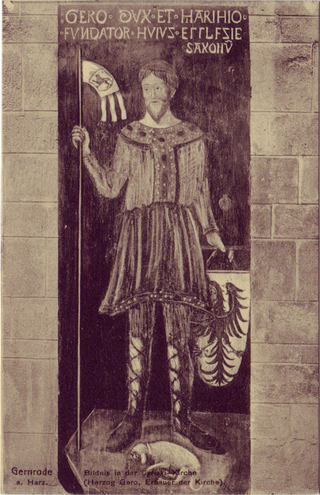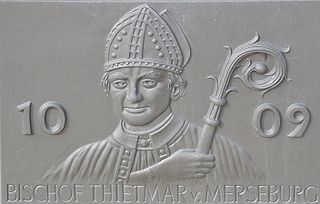
Mieszko I was the first ruler of Poland and the founder of the first independent Polish state, Civitas Schinesghe also known as the Duchy of Poland. His reign stretched from 960 to his death and he was a member of the Piast dynasty, a son of Siemomysł and a grandson of Lestek. He was the father of Bolesław I the Brave and of Gunhild of Wenden. Most sources identify Mieszko I as the father of Sigrid the Haughty, a Scandinavian queen, the grandfather of Canute the Great and the great-grandfather of Gunhilda of Denmark, Canute the Great's daughter and wife of Henry III, Holy Roman Emperor.
Taara, also known as Uku or Jumal, is a prominent god in Estonian mythology, with a strong resemblance to the Finnish Ukko and the Germanic Thor.

Gero I, sometimes called the Great, was a German nobleman who ruled an initially modest march centred on Merseburg in the south of the present German state of Saxony-Anhalt, which he expanded into a vast territory named after him: the marca Geronis. During the mid-10th century, he was the leader of the Saxon Ostsiedlung.

The Recknitz is a river in Mecklenburg-Vorpommern in northeastern Germany. The Recknitz's glacial valley stretches as far south as the heights at Glasewitz near Güstrow. The river has no definite source, but rather builds up from streams and drainage ditches. The ditches of the Schaalbeke and Pludderbach have their water flow split between Liessow and Laage, but most of the water flows north as the Recknitz, while the lesser flow, called the Augraben, runs south to the river Nebel.

Thietmar, Prince-Bishop of Merseburg from 1009 until his death, was an important chronicler recording the reigns of German kings and Holy Roman Emperors of the Ottonian (Saxon) dynasty. Two of Thietmar's great-grandfathers, both referred to as Liuthar, were the Saxon nobles Lothar II, Count of Stade, and Lothar I, Count of Walbeck. They were both killed fighting the Slavs at the Battle of Lenzen.
Godfrey II (965–1023), called the Childless, son of Godfrey I, Count of Verdun was the first of several members of his family to become duke of Lower Lorraine which roughly corresponded to modern Belgium and the Netherlands.
Ingelmarius was a Norman knight of humble origins who served Roger I, the count of Sicily. In reward for his good service to Roger, Ingelmarius was given the hand of the widow of Roger's nephew Serlo II of Hauteville, the lady Altruda of Boiano. In addition to giving Ingelmarius control of the vast conquests and rights of Altruda's first husband, the marriage also raised Ingelmarius up socially into the nobility.
Wichmann II the Younger was a member of the Saxon House of Billung. He was a son of Count Wichmann the Elder and his wife Frederuna, a niece of Queen Matilda. The cousin of Emperor Otto I became known as a fierce enemy of the ruling Ottonian dynasty.

The Billung March or March of the Billungs was a frontier region of the far northeastern Duchy of Saxony in the 10th century. It was named after the family which held it, the House of Billung.
The Nakonids were the leading noble family of the Slavic peoples of the Elbe River from ca. 960 until 1129. They were themselves of Obotrite origin and engineered the formation of a Slavic principality in the region. They became extinct in the male line in the early 12th century. Their capital was Mecklenburg Castle.

Silva Carbonaria, the "charcoal forest", was the dense old-growth forest of beech and oak that formed a natural boundary during the Late Iron Age through Roman times into the Early Middle Ages across what is now western Wallonia. The Silva Carbonaria was a vast forest that stretched from the rivers Zenne and the Dijle in the north to the Sambre in the south. Its northern outliers reached the then marshy site of modern Brussels.

Thomas the Archdeacon, also known as Thomas of Spalato, was a Roman Catholic cleric, historian and chronicler from Split (Spalato). He is often referred to as one of the greatest sources in the historiography of Croatian lands.

Otto I, traditionally known as Otto the Great, was East Frankish king from 936 and Holy Roman Emperor from 962 until his death in 973. He was the eldest son of Henry the Fowler and Matilda of Ringelheim.

The Lutici or Liutizi were a federation of West Slavic Polabian tribes, who between the 10th and 12th centuries lived in what is now northeastern Germany. Four tribes made up the core of the federation: the Redarians, Circipanians (Circipani), Kessinians and Tollensians (Tholenzi). At least in part, the Lutici were a continuation of the Veleti. In contrast to the former and the neighboring peoples, the Lutici were not led by a Christian monarch or duke, rather power was asserted through consensus formed in central assemblies of the social elites, and the Lutici worshipped nature and several deities. The political and religious center was Radgosc.

In the Slavic revolt of 983, Polabian Slavs, Wends, Lutici and Obotrite tribes, that lived east of the Elbe River in modern north-east Germany overthrew an assumed Ottonian rule over the Slavic lands and rejected Christianization under Emperor Otto I.
Stoigniew was an Obotrite leader, reigning in the middle of the tenth century. He is mentioned as a member of the princely Nakonid dynasty in the medieval chronicles of Thietmar of Merseburg and Widukind of Corvey.
Count Emmo, Immo or Immon, was the name of at least one important Lotharingian nobleman in the 10th century, described by medieval annalists as a cunning strategist. Various life events of a nobleman of this name were recorded, although historians differ about exactly which records refer to the same person or people. The first record claimed for him shows him as a young noble granting land to a new vassal in the Condroz region in 934, a member of the entourage of Duke Gilbert of Lotharingia. During the revolt of Gilbert which ended at the Battle of Andernach in 939, he switched sides. After the revolt he was personally associated with the fort at Chèvremont, near Liège. It becomes difficult later in Immo's life to be sure that all records mentioning a count of this name are referring to the same person.
Ansfried or Ansfrid, was a 10th-century count, who held 15 counties in Lotharingia, a former kingdom which contained the low countries and Lorraine, and which was coming under the control of the new Holy Roman Empire during his lifetime. He is sometimes referred to as "the elder" in order to distinguish him from his nephew, Bishop Ansfried of Utrecht, who was also a powerful count until he became a bishop.
The Bethenici were a West Slavic people living east of the Elbe river in the ninth century. They lived near the confluence of the Elbe and the Havel, probably between the rivers alongside the Smeldingi.

Hennil or Bendil is an alleged agrarian Slavic god worshipped by the Polabian Slavs. He was mentioned by Bishop Thietmar in his Chronicle as a god who was represented by a staff crowned by a hand holding a ring, which is interpreted as a symbol of fertility. However, there is no general consensus on the authenticity of the deity.











